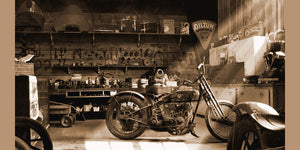Your Go-To Motorbike Shop for Quality Parts and Accessories
Your Go-To Motorbike Shop for Quality Parts and Accessories
Blog Article
Recognizing the Important Parts of a Motorcycle: A Comprehensive Overview for Lovers
For motorbike fanatics seeking to boost their riding experience and guarantee their bikes run efficiently, comprehending the essential parts of a motorcycle is extremely important. Each aspect, from the engine's detailed workings to the essential function of the stopping systems, not just affects efficiency however also security and convenience. This overview will certainly go through the fundamental components that every motorcyclist should be familiar with, enabling informed options in both upkeep and possible upgrades. As we start this expedition, one must ask: just how does each part interact to create the smooth adventure every enthusiast seeks?
Engine Elements

The camshaft plays an important role in regulating the timing of the engine's valves, guaranteeing the specific opening and closing essential for reliable fuel and air intake, in addition to exhaust expulsion. This timing is vital to preserving ideal engine efficiency and efficiency. Additionally, the carburetor or fuel injection system, depending on the motorbike design, is responsible for blending air with fuel in the right proportion for combustion.
The air conditioning system, either air or liquid-based, functions to maintain the engine's temperature within functional limits, protecting against getting too hot and guaranteeing long life - mx parts nz. Each part, meticulously developed and incorporated, adds to the smooth operation of the engine, defining the motorbike's power outcome and total performance
Transmission System
Essential to the motorbike's functionality, the transmission system ensures reliable power transfer from the engine to the wheels. This system comprises numerous important parts, consisting of the clutch, transmission, and final drive, each playing an important role in equating the engine's power right into movement. The clutch, commonly operated by a hand bar, offers to disengage the engine and involve from the transmission, permitting for smooth equipment modifications and controlled acceleration.
The gearbox, frequently referred to as the transmission proper, contains a collection of equipments that motorcyclists can manually shift through to readjust the bike's rate and torque outcome. These gears are prepared in a series that allows the motorbike to speed up smoothly and keep optimum engine performance across numerous rates. Many motorbikes utilize a consecutive transmission, needing the biker to shift equipments in an established order.
Braking Mechanisms
While recognizing the transmission system is vital to utilizing a bike's power, just as crucial is the ability to regulate and stop that power effectively, which is where stopping mechanisms enter play. Brakes are important for security and efficiency, giving the rider with the needed control to browse numerous terrains and problems. Usually, motorcycles include two kinds of braking systems: disc brakes and drum brakes.
Disc brakes are more common in modern motorbikes due to their remarkable performance. They are composed of a brake disc, caliper, and pads. When activated, the caliper squeezes the brake pads versus the rotating disc, converting kinetic power into warm, thereby slowing down the wheel. This system supplies better warmth dissipation, consistent efficiency, and enhanced quiting power, especially in wet problems.
Alternatively, drum brakes, though much less common, are still found in some motorbikes. They function by pushing brake footwear against the inner surface of a drum connected to the wheel. While generally less efficient in warmth dissipation and stopping power, drum brakes are easier and extra economical.
Recognizing these stopping systems' nuances enables motorcyclists to keep their motorbikes properly and appreciate the engineering that makes sure reliable and secure quiting.
Suspension and Guiding
Suspension and guiding systems are crucial elements that substantially affect a bike's handling and adventure convenience. The shock absorber, including forks at the front and shock absorbers at the rear, takes in road irregularities, boosting security and control. Front forks, inverted or usually telescopic, compress and rebound to alleviate effects, while rear shock absorbers preserve tire contact with the roadway, crucial for grip and safety.
Guiding, focused around the handlebars, attaches the cyclist to the motorcycle's directional control. The steering head bearings ensure smooth operation, allowing precise ability to move. Correct positioning and upkeep of these bearings are essential for predictable guiding feedback and minimizing biker exhaustion.
The suspension's adjustability is an additional vital aspect; preload, damping, and rebound setups enable customization to match various riding conditions and designs. This flexibility is vital for optimizing efficiency, whether browsing metropolitan streets or dealing with rugged routes. Developments like electronic shock absorber provide real-time adjustments, improving ride top quality throughout diverse surfaces.

Electric Systems
After guaranteeing a regulated and smooth trip with efficient suspension and steering systems, interest turns to the electric systems, a critical facet of contemporary bikes. These systems play an important role not Clicking Here just in beginning the engine however additionally in powering numerous elements that boost the performance and safety and security of the bike.
At the heart of a motorbike's electrical system is the battery, which stores electrical power necessary for starting the engine and powering complementary systems - motorcycle parts nz. The generator or generator, paired with the rectifier-regulator, ensures the battery continues to be charged while the motorbike functions, transforming power into electrical energy and preserving voltage levels
The ignition system, another vital element, is accountable for firing up the air-fuel blend in the engine's cyndrical Look At This tubes. Modern bikes often utilize an electronic ignition system, offering greater efficiency and reliability contrasted to traditional systems.
Illumination systems, consisting of headlights, tail lights, and signs, are additionally essential, making certain visibility and safety for the rider. Additional electronic parts such as sensing units, control devices, and shows contribute to advanced features like fuel shot monitoring, anti-lock stopping systems (ABDOMINAL), and digital control panels, additionally improving the riding experience.
Final Thought
An extensive comprehension of a bike's necessary components, consisting of the engine, transmission system, braking devices, suspension, steering, and electric systems, is vital for enthusiasts intending to optimize efficiency, convenience, and safety and security. Proficiency of these elements permits for informed decisions pertaining to maintenance and upgrades, eventually boosting the riding experience. By integrating this understanding, riders can ensure their bikes operate at peak effectiveness and integrity, thereby maximizing both pleasure and longevity of their cars.
For motorbike fanatics looking to elevate their riding experience and guarantee their bikes run efficiently, understanding the necessary components of a motorbike is critical.Important to the motorcycle's capability, the transmission system makes certain efficient power transfer from the engine to the wheels.While recognizing the transmission system is vital to utilizing a motorbike's view publisher site power, similarly crucial is the capacity to regulate and quit that power effectively, which is where braking systems come into play. Normally, bikes include 2 kinds of stopping systems: disc brakes and drum brakes.
A detailed understanding of a bike's essential components, including the engine, transmission system, stopping devices, suspension, guiding, and electric systems, is crucial for fanatics intending to maximize safety, comfort, and efficiency.
Report this page